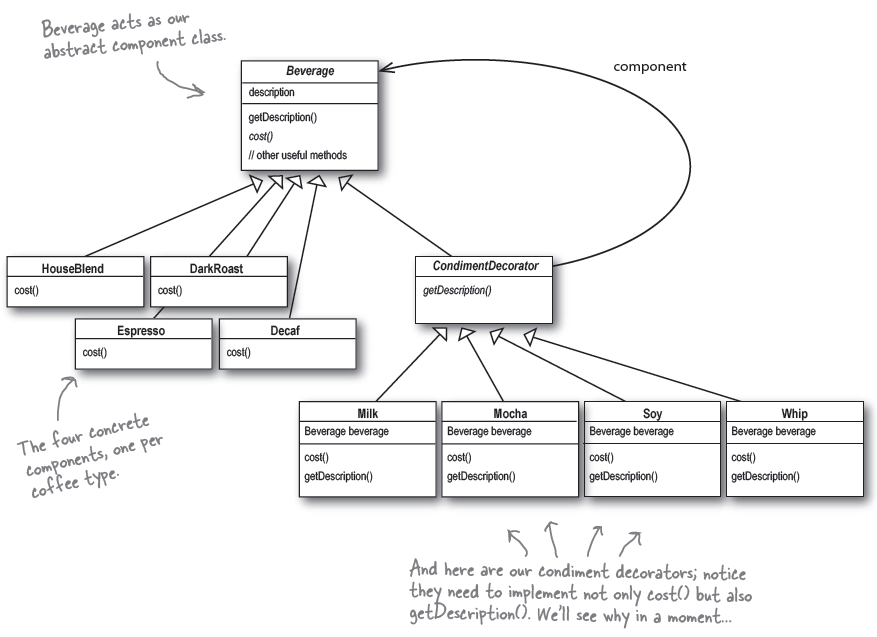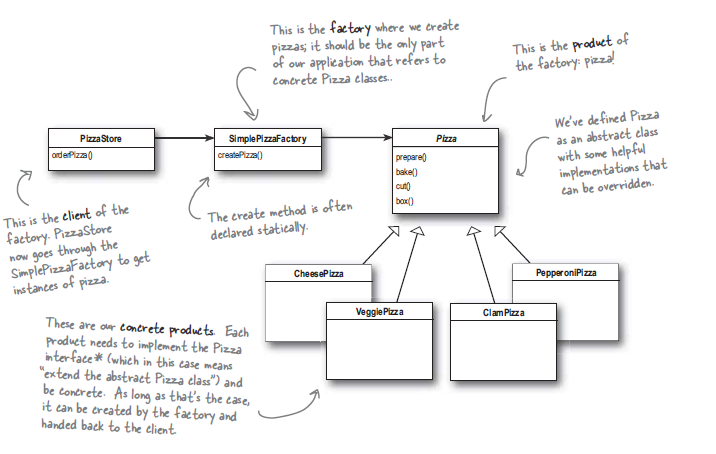Just making some notes as I attempt to work through this book and start using recognised Design Patterns.
Strategy
A family of algorithmns.

Observer
The Observer Pattern defines a one-to-many dependency between objects so that when one object changes state, all of its dependents are notified and update automatically.

The Decorator Pattern
Decorate your classes at runtime using a form of object composition.
Example is zillion types of Starbucks all * with * different additions ** EspressoWithSteamedMilkandMocha **.
Identify areas which may change.
- Take a DarkRoast object
- Decorate it with a Mocha object
- Decorate it with a Whip
Decorators implement the same interface as the component they are going to decorate. Pg 95 the Decorator extends the Beverage class.

https://sourcemaking.com/design_patterns/decorator/php
https://sourcemaking.com/design_patterns
This is how you use it:
drink = new Darkroast();
drink = new Mocha(Drink);
drink = new Whip(Drink);
The Factory Pattern
new - think when newing, is this better in a Factory?
Identify the aspects that vary and separate them from what stays the same. ** An object that just creates objects, other objects use this, when they need new objects = Factory. **
pizza = factory.createPizza(type);
Simple Factory

Got the simplw one working OK.
Tie the store and the factory together.
** Come back to this ** Pg - 139.
The Singleton Pattern
- One of a Kind Objects - only one instance *
The PHP Way:
// General singleton class.
class Singleton {
// Hold the class instance.
private static $instance = null;
// The constructor is private
// to prevent initiation with outer code.
private function __construct()
{
// The expensive process (e.g.,db connection) goes here.
}
// The object is created from within the class itself
// only if the class has no instance.
public static function getInstance()
{
if (self::$instance == null)
{
self::$instance = new Singleton();
}
return self::$instance;
}
}
The Command Pattern - Encapsulating Invocation
Remote control analogy. Lots of classes with different interfaces. Command object sits in the middle and decouples.
- The Command Pattern * encapsulates a request as an object, thereby letting you parameterize other objects with different requests, queue or log requests, and support undoables operations.
** Read over this chapter again **
Adapter
Travel plug analogy.
Make an adapter so that a Turkey can be used like a Duck.
public class TurkeyAdapter implemements Duck{
Turkey turkey;
public TurkeyAdapter(Turkey turkey){
this.turkey = turkey;
}
public void quack() {
turkey.gobble();
}
public void fly() {
turkey.hop();
}
}
Summary
Basically just create an adapter class which sits between a client and adaptee and translates the requests.
Facade Pattern
Analogy home theatre, lots of tasks to watch a film. Facade Pattern takes a complex system and makes it easier by implementing a Facade class that provides one, more reasonable interface.
Facade will just have one method (watchMovie) which triggers all the sub tasks.
- The Facade Pattern * provides a unified interface to a set of interfaces in a subsystem. Facade defines a higher-level interface that makes the subsystem easier to use.
** A Simplified Interface **
The Principle of Least Knowledge
“talk only to your immediate friends”
From a method in an object you can only invole methods which belong to:
1, The object itself 2, Objects passed in as a parameter to the method 3, Any object the method creates or instantiates 4, Any components of the object
Encapsulating Algorithmns - The Template Method Pattern
Brewing tea and coffee example.
CaffeineBeverage contains boilWater() and pourInCup(). Tea and Coffee extend and code for brew and add condiments is in them.
** The Template Method Pattern ** Defines the skeleton of an alogrithm in a method, deferring some steps to subclasses. Subclasses can alos redifine certain steps.
** The Hollywood Principle **
Prevents dependency rot - high level components depending on low level components.
With the Hollywood Principle we allow low-level components to hook themselves into a system. High-level components say “don’t call us, we’ll call you”.
In the tea/coffee example, the Caffeine Beverage class calls Tea and Coffee, not the other way around.
Well-Managed Collections - The Interior and Composite Patterns
The Iterator Pattern
- Relies on Iterator Interface
- Just had functions like hasNext() and next()
- Create classes which implement this, for each thing we need to iterate.
The Composite Pattern
The State Pattern
- Define a state interface.
- Create a class for each state.
State implements the behaviours that are appropriate for that state.
The class that uses these has a ** current state ** and when it calls the methods, the correct code for the current state is executed.
The Proxy Pattern
Proxies control and manage access. They stand in for the objects they are protecting.
Patterns in the Real World
Notes
** Look up, how to choose a design pattern. **
** Watch the Laracast again **
Single Responsibility (S in SOLLID)
A class should have only one reason to change.
OO Principles
Encapsulate what varies Favor composition over inheritance Program to interfaces not implementations Strive for loosely coupled designs between objects that interact
** Code should be closed to to change, open to extension **
Design Principle
Identify the aspects of your application that vary and separate them from what stays the same.
- Composition over inheritance * (or composite reuse principle) in object-oriented programming is the principle that classes should achieve polymorphic behavior and code reuse by their composition (by containing instances of other classes that implement the desired functionality) rather than inheritance from a base or parent class.[2]
pg86